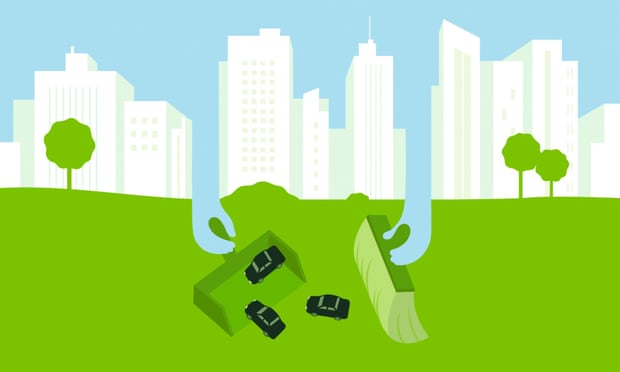The big idea: should cars be banned from cities?
Streets have been optimised for one thing: traffic. A kind of ‘urban rewilding’ could return them to the complex social ecosystems they once were

There has been justified excitement around the idea of rewilding over the past few years, with projects popping up all over the UK that aim to restore wildlife and encourage regenerative farming practices. It is now generally accepted that monoculture – largely brought on by the expansion of farmland – is bad for our countryside. But what about our cities?
Like natural ecosystems, cities also used to be complex and diverse places that hosted a whole range of different activities. Our streets were public spaces, used for many purposes: work, trade, play, socialising and transportation.
Rebecca Solnit describes our relationship to our city streets perfectly in her book Wanderlust: “The word citizen has to do with cities, and the ideal city is organised around citizenship – around participation in public life.” And that is how it once was.
But just as swathes of our countryside were repurposed for farming, over the past century our city streets have been optimised for one goal: to move people around as quickly as possible, unhindered by anyone using public space for other purposes. This has its benefits – who wouldn’t argue that it is useful to be able to get from one side of a city to another quickly and efficiently – but they have come at a cost. Our shared urban environment, which used to be for everyone, is by and large dominated by moving and parked cars.
Where we live, for example, in the Netherlands, there are almost as many parking spaces as people; if you were to put all these spaces together, they would take up more room than the total surface area of Amsterdam. Most are on public land, but cannot be used by the public in any other way. You may be surprised to hear this, since the Netherlands is widely known as the cycling capital of the world. And yes, we have cycling lanes and bicycle parking too, but these still reduce our streets to just one purpose: transportation. In short, we have allowed our cities to become monocultures.
This development wasn’t inevitable. When cars first started to flood cities (in the US from the 1920s onwards, and in Europe from the 1950s), public opinion dictated that they should adapt to the existing system, so pedestrians took precedence.
But, as Peter Norton explores in his book Fighting Traffic, within the span of a single decade, the idea took hold that the city should adapt to the car. Traders were no longer allowed to offer their wares in the streets, only in dedicated, regulated markets. Children stopped playing outside and had to be taught from an early age to watch out for motorists, rather than motorists keeping an eye out for them. Pedestrians were consigned to the pavement. The shift towards how our cities operate today had begun.
Look at your street. What do you see? Probably a pipeline for fast and free-flowing car traffic. Maybe a cycle lane that supports another kind of – admittedly more environmentally friendly – traffic. Parking spaces. Possibly bike hangars. Not a place for neighbours to congregate, children to play together. Not a place for citizenship.
Is there another way? Well, some cities are starting to “rewild”. Barcelona is democratising its public space to include urban patios and parks, reclaiming its streets from traffic. Cars will still be allowed, but they will constitute just one use of public space, not the main reason for its existence.
In the same spirit, Groningen, in the Netherlands, known for its progressive steps to reclaim streets for bikes, recently adopted a set of guidelines that state that moving about is just one thing that a street should facilitate, as well as, for example, better health, an awareness of cultural history, or the city’s ability to adapt to the climate emergency. Paris, meanwhile, has a 15-minute city plan that aims to create self-sufficient communities where everything you need is within a 15-minute walk or cycle.
READ RELATED: ‘It starts as a line of light, then works its way across my vision’: the disorienting mystery of migraine auras
Is that enough, though? People are so used to making way for traffic, perhaps an even more radical change is needed in order to shake us out of that mindset. What would happen if we banned cars from cities altogether?
Parts of some cities have already done this with great success – albeit temporarily: on car-free days, for marathons, or to host street parties for the Queen’s Jubilee.
In some places, there have been more permanent changes. For example, in Utrecht, an entire canal that had been filled in to make space for a motorway in the 1970s was turned back into a canal in 2020, to the delight of local residents. An alderman at the time, Eelco Eerenberg, said: “Now that the canal is back, it provides a beautiful connection to a plethora of important urban functions. Among other things, the station, a pop stage, theatre and greenery have found their place at the water.”
And then there are the cities that have always been car-free, such as Venice, one of the most beautiful and beloved places in the world.
With the rising cost of petrol, our growing awareness of the damage that cars inflict on our environment, and increased parking costs and congestion charges, surely now is the time to find a better way – one that allows us to restore our cities to the social hubs they once were, to reverse the scourge of monoculture.
Imagine looking out of your window but, instead of rows of parked cars and lanes of traffic, you see a communal vegetable garden, a shared barbecue, a play area for children, wildflowers to attract insects. Different forms of transportation, sure – maybe a couple of electric cars – but with mobility no longer taking precedence. The “natural ecosystem” of the city restored.
Thalia Verkade and Marco te Brömmelstroet are the authors of Movement: How to Take Back Our Streets and Transform Our Lives (Scribe), translated by Fiona Graham.
Further reading
Wanderlust by Rebecca Solnit (Granta, £9.99)
Fighting Traffic: The Dawn of the Motor Age in the American City by Peter D. Norton (MIT, £25)
Earthopolis: A Biography of Our Urban Planet by Carl H. Nightingale (CUP, £25)
Source: Health & wellbeing | The Guardian





